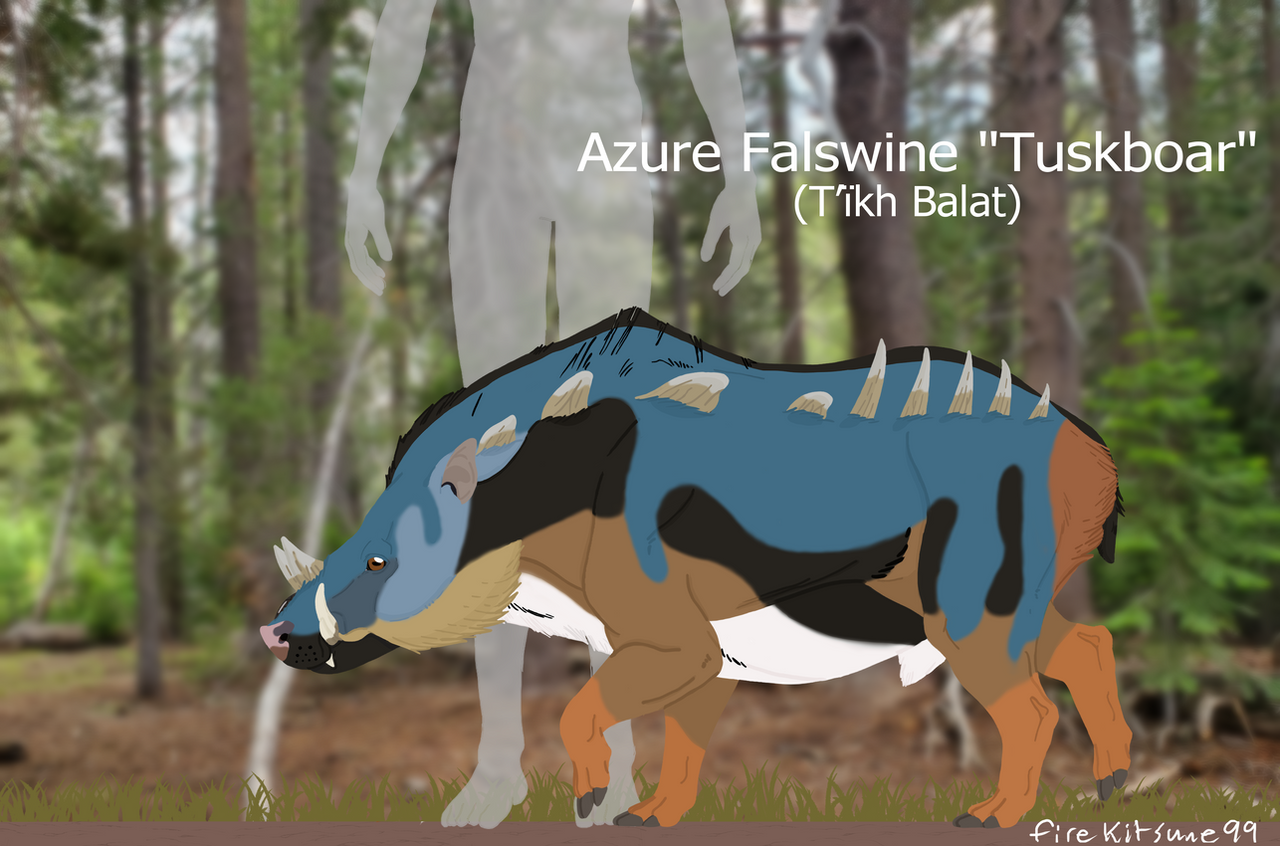HOME | DD
 firekitsune99 — The Azure Menace (Azure Falswine)
by-nc-nd
firekitsune99 — The Azure Menace (Azure Falswine)
by-nc-nd

#alternateearth #alternatehistory #alternatereality #alternateuniverse #animal #animalart #animaldrawing #digitalart #digitalartwork #digitalcoloring #digitaldrawing #digitalillustration #fantasyart #fantasyartwork #fantasycreature #fantasycreatures #fantasyillustration #artillustration #alternate_universe #speculativeevolution #artworkdigital #speculativezoology #speculative_evolution #speculative_biology #speculativeecology
Published: 2022-02-16 07:49:26 +0000 UTC; Views: 2960; Favourites: 46; Downloads: 2
Redirect to original
Description
Aggression/ Danger to humans: High - Medium
Element/ Ailment: Scent Marking
The Azure Falswine “Tusk Boar” or T’ïkh Balat/ T’ïkhxpïm (Tuhk Balat/ Tuhk-Pym) meaning “Tusk Boar/ Falswine”, sometimes called the Azure Menace, is a small even-toed ungulate that inhabits the forests of the Northern Eastern Continent of Atterra and is a chiefly vegetarian omnivore. Being a low tier herbivore, the Azure Falswine travels in herds (Also known as gangs) that can be up to fifty animals strong. What the Azure Falswine lacks in size and weight, it more than makes up for in attitude and defense. With a robust sense of smell, decent eyesight, and good hearing, the Azure Falswine keeps a vigilant lookout for predators in the Atterran wilds at all hours of the day. Gangs of Azure Falswine will have lookouts and sleeping individuals rotate between guard duty and sleeping periodically, with pregnant females and kids getting priority when it comes to sleeping during the night. Should a threat be spotted then the lookouts will sound an alarm to wake up the entire herd and begin to form a defensive ball around the young and pregnant females. Due to their poor night vision, Tusk boars will often try to use their sense of hearing and smell to try and sniff out the threat to their gang. This is where the scent glands located on their snouts just below their horns come into play. When not used to mark food and nesting spots found by other members of the gang in their territory, the scent gland is used for painting targets for the rest of the Tusk Boars to swarm and attack.
This method of attacks works due to the social nature of the Azure Falswine, and the way they form bonds within the gang. All species of Falswine rub each other with their scent glands (Both males and females have them) to bond and intermix their scents. This effectively makes a herd have a ‘distinct scent’ unique to their gang comprised of all the individuals in the gang. Making it easy for Falswine to detect outsiders or rival herds or gangs at the edges of their territory to attack. Couple this with the scent gland producing a muskier and sharper scent when under stress means that when a predator hunts a Falswine, it or the surrounding area is marked with the alarm scent from the thrashing Falswine. Being a vindictive genus like Earth’s Peccaries or Cape Buffalo, upon smelling the musk of duress from another member of their gang or species, the whole gang will move as one to attack the threat to their herd. Azure Falswine and other Tuskboars have been known to swarm and kill Red-Maned Quill Tails and Guild Huntsman with their sheer numbers and tenacity. There have been a few recorded cases of Falswine waiting up to six hours at the base of a tree a party of Huntsman climbed into, guarding the carcasses of their fellow gang members before leaving the huntsman and dead behind. This has made Guild Huntsman and other predators wary of hunting Tuskboars and who have taken a hit and run approach when hunting Azure Falswine. Should a predator or Huntsman find themselves marked by a Tuskboar, the best course of action is to take the carcass and run or cause enough damage to the herd by killing several pursuing members of the gang so the herd panics and breaks off pursuit. Besides that, some predators such as Chardanes have begun constructing pitfalls and other traps to hunt Tusk Boars. The Guild has elected for the use of bow hunting for a clean kill or the use of light stones to blind and panic the gang of Falswine.
Besides their scent gland, the Azure Falswine and other Tuskboars are equipped with horns on their snout, four tusks, fangs derived from their bicuspids, bone plates on their shoulders, bony spines on their flanks, and hard cartilage plates on their rear. The bony plates and spines like the horns are covered in a thin layer of keratin and are used to protect the Tuskboars spine from attack by larger predators. The plates and spines are not connected with the Azure Falswine’s skeleton and instead are anchored into the upper layer of the muscle to not impede the movement or flexibility of the animal. The hard cartilage plating on the rump of the Azure Falswine is to protect the animal’s rear from the jaws of predators and allow time for the Tuskboar to turn around and gore the predator. When the Tuskboar is not out for the blood of the enemies of its gang, the Azure Falswine uses its hard cartilage reinforced snout to dig up roots, tubers, mushrooms and underground worms and grubs to feed on. Besides those, the Falswine likes to eat fallen fruit on the forest floor and low growing ferns, shrubs, and nuts including Wax Fruit. Tuskboars mark the edges of the gang’s territory by rubbing their scent glands on the rocks and trees at the far ends of their range which on average are around a thousand acres in size. The herd periodically moving from feeding ground to feeding ground on well-worn trails throughout the year with the gang only deviating from the path should one of the two to three small scouting parties (usually between three to 5 individuals in size and usually made up of senior members of the gang) find a new source of food or nesting grounds for the gang.
Tuskboars can mate and give birth in any season to twins or triplets per litter, with two births happening per year and primarily happening in the spring and summer months. Female Tuskboars will gestate their kids for five months before giving birth to a litter of kids that’re usually around a pound in weight at first breath. Kids are very vocal and playful, lacking the bone plating of mature Falswine and will nurse for eight weeks before weaning and moving onto solid food. Baby Azure Falswine are usually reddish and black in color with white bellies like adults but lack the characteristic blue fur (The blue coloring being due to hair follicle structure and not blue pigmentation in the fur) of mature individuals. Tuskboars mature at two years of age and can live up to an average of ten years in the wild with captive or lucky individuals living over twenty years of age. Male and female Falswine are identical in appearance, with the only way to tell the difference between the genders is their size. Male Tuskboars are fifteen percent larger than females in height and body mass, with females almost always accompanied by their kids in the spring and summer months. When a female of the gang goes into heat, the dominate male (Often the oldest and strongest surviving male) of the gang will breed with the fertile female. Shoving matches will ensue if any of the other male Falswine want to dethrone the gang’s Patriarch for breeding rights. So far attempts to domesticate Tuskboars have been less than stellar, the aggressive and high-strung nature of Tuskboars makes them a poor candidate for domestication. Making it so that certain Hakdor tribes that are almost as stubborn as the Tuskboars themselves, to try breeding out the aggression towards humanoids as a means of domestication. A method which is yielding some positive results after almost a century of breeding, creating a more agreeable breed of Falswine to use for food or pets. Something which human breeders are having trouble accomplishing and more than one has lost their lives attempting to recreate.
























